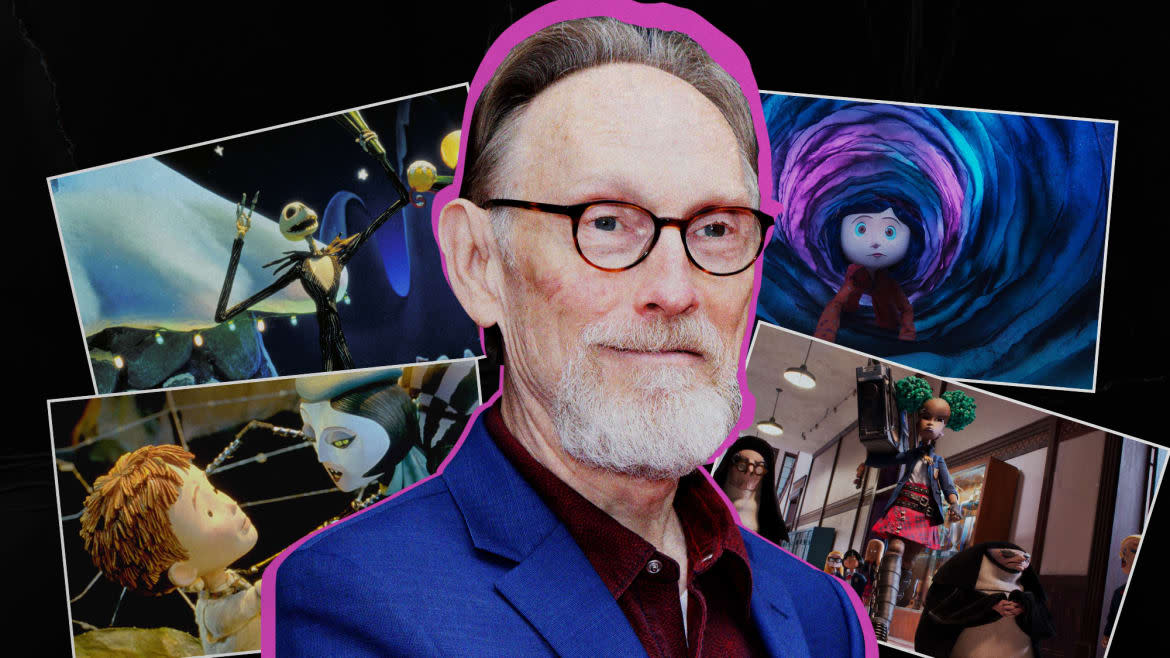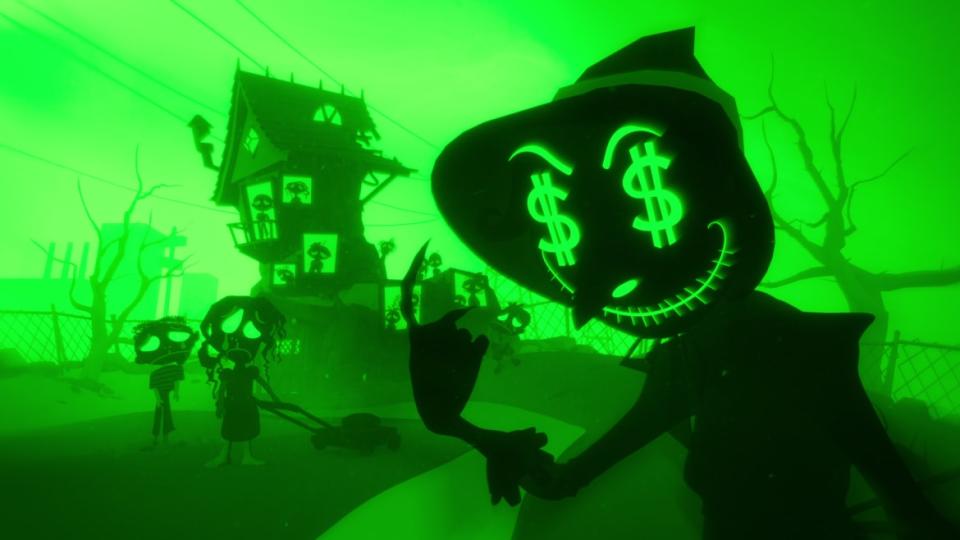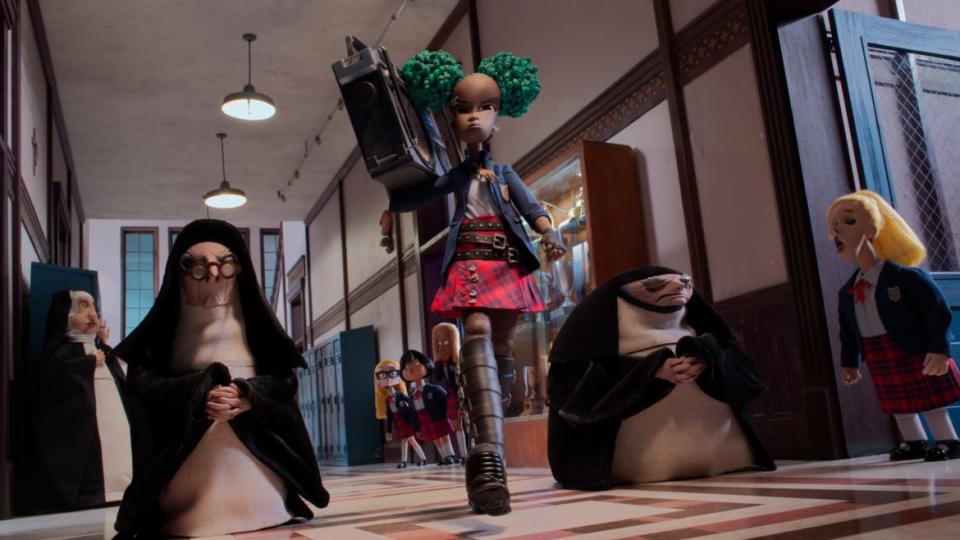The Stop-Motion Animation Master Is Back to Scare Your Kids

It’s been thirteen years since the last film from acclaimed stop-motion animation auteur Henry Selick, but that all changes on October 21, when he makes his grand return to theaters with Wendell & Wild.
Premiering one week later on Netflix, the director of The Nightmare Before Christmas and Coraline’s first feature since 2009 is a recognizably dark and weird fable about a punk-rock orphan named Kat (Lyric Ross) who strives to resurrect her deceased parents with the aid of two demons, Wendell (Keegan-Michael Key) and Wild (Jordan Peele), who yearn to break free from their underworld domain in order to construct a Dream Faire. The adventure that ensues is equally mad and malevolent, and so jam-packed as to be almost bursting at the seams: a coming-of-age odyssey that features the comedic hijinks of Key & Peele, celebrates political protest, and takes critical aim at the private prison-industrial complex. Carnivalesque to its core, it’s a phantasmagoric fantasia of the spooky, the surreal, the sweet, and the silly.
For Selick, Wendell & Wild is another triumph of stop-motion inventiveness, with plentiful CGI flourishes enhancing its wondrous aesthetics. There isn’t a moment throughout this saga that doesn’t boast some amazing sight or sound, as well as a goofy one-liner or stinging sociopolitical point. Co-scripted by Peele, it’s a sharp and ridiculous portrait of brave multicultural loners banding together to fight for themselves and their communities, all of it energized with electric verve and infused with a potent sense of longing, grief, and regret. Like its predecessors, which remain some of the most beloved and influential animated efforts of the past three decades, it’s a kids’ movie that isn’t afraid to tackle mature themes and emotions even as it indulges in squishy, gooey grotesqueness.
Henry Selick on Directing ‘The Nightmare Before Christmas’
No one makes them quite like Selick, a singular talent whose voice has been silent for far too long on the mainstream cinematic scene. Thus, Wendell & Wild’s debut is cause for celebration, and to do just that, we sat down with the artist to talk about where he’s been, how his latest came together with Peele, and why he loves scaring the pants off young children.
Do you hear a lot about how your films have frightened kids? My daughters were thoroughly rattled by Coraline, which they never let me forget.
I believe that kids like to be scared, and it’s kind of the job of parents to help make a choice about what’s too much for them [laughs]. But there are so many cases where you find someone older, and the film that scared them the most is one of the things they love the most. It probably taught them how to deal with fear. As long as there’s a safe place to be after the scare—that they’re not trapped in that world—I think they’ll be okay. I think kids are very resilient, and scaring kids is how we warn them of dangers throughout history. You know, the Grimms’ Fairy Tales—out in the woods, horrible and unexpected things could happen! Or you’re living in a cave with your family and you’ve got a storyteller warning about the bear or the saber-tooth cat that’s going to gobble you up if you’re not careful.
So yes, I’ve heard it a lot, and 99 out of 100 times, it was positive. There’s occasionally a mom who’s angry at me [laughs], like back with Coraline, and I said, I’m sure your kid will be fine. But it was PG! You’re supposed to be the guide.
Do you have to fight to keep your films scary?
It’s a certain type of a fight. It’s just the nature of what I do. I’m always sort of on this edge. I make horror films for kids, right? In the end, the motto is, “For Brave Children of All Ages.” I think I’m just sometimes more in tune with what’s going to work than the powers-that-be. Back on A Nightmare Before Christmas, I knew that Tim’s character designs were very charming and nothing really that frightening. I didn’t think any kids were going to be that afraid of that. But Disney was so afraid that they wouldn’t put it out under their label; they put it out as a Touchstone movie. It was only years later that they realized, no, we’ll make more money in merchandising if we put Disney on there, so: “Welcome, Nightmare, you were always a Disney film, I swear it!” [laughs]

A scene from Wendell & Wild
Coraline was tricky because it was Laika’s first stop-motion feature, and I got full creative support. But the distributor, Focus—which was known for edgy films—was terrified. One of our producers—a good friend, Bill Mechanic—was a little terrified. The deal was, if we don’t get a PG rating, then I have to cut things. I was prepared, even though I didn’t want to. But we got a PG rating. I don’t know if we should have, actually, because it’s pretty damn intense! But I always felt like, this one’s going to get them, but it’s okay. It shows an ordinary girl—not a girl with superpowers, she’s not extraordinarily bright, she’s not extraordinarily anything, but she’s brave and clever. I loved the idea that that’s what it took to overcome a terrible evil and save her parents.
Was it the same on Wendell & Wild?
Working on this film, we had our discussions and made adjustments with Netflix. The thing about Netflix and this film, and why Jordan Peele and I thought it was the perfect home, was because right from the start when we pitched it and showed them artwork, they said we love this, and here’s the deal with Netflix: If we love you and your project, we will make this film. Just consider it a delayed green-light. They made a commitment, and that meant more to us than what anyone else had said. They stayed true to their words, and we went through a lot. But we also went through a lot of creative discussions about what’s too scary. Like, when Kat’s writing on the chalkboard as the kids are being punished for doing nothing except confronting Father Bests (back from the dead), and the nuns throw an eraser and hit Kat in the head because she laughed, I had her writing, “I’m going to kill those nuns, I’m going to kill those nuns.” Netflix—and I think rightfully so—said, given the stuff that happens in schools, I don’t think we want to say that. I had to agree.
There are little things like that. But not much at all; they were more like tonal adjustments. I didn’t have to fight too hard. But there’s always going to be somebody who thinks, this is not what kids need! I mean, most kids have internet access and see a lot, and it’s really naïve to think you’re going to spoon-feed them stuff—unless they’re three years old—that’s going to be healthy for them. This film got a PG-13 rating, and it was always in our contract that we wanted to be able to get that rating if we needed too. Yet it’s not overly scary, there’s no sex, there’s not much in the way of language. But I don’t mind that rating because I think younger kids—like 9 or 10—will want to see the film more.
Are these issues at least partially responsible for the thirteen-year gap between your films?
This is definitely a big part of the difficulty of getting another film finished. Go back to Coraline. The material underneath it, the book that the movie is based on, it took a very long time to find a studio to back that film, just because tonally, they thought, oh no, this is too dark and intense. After Coraline, which was well-met and a success…I did that up in Portland, which is where Laika is, and we did this film there as well. But my home base is just north of San Francisco, and because Pixar is close by and I know a lot of those folks, I ran into John Lasseter while we were mixing sound on Coraline at Skywalker Sound. He saw some of the movie, loved it, and I ended up making a deal with Disney and Pixar to do another film. I pitched many things, but it’s the film The Shadow King that they responded to, and we went into pre-production and actual production. But those questions of the tone…
It’s just crazy, because going back to Nightmare, they were afraid of the tone of that, and they wouldn’t put it out as a Disney film, and here they are afraid again about the exact same thing. It’s sort of a repeat for my whole filmmaking life. But it wasn’t just that. It was the tone—a little dark and creepy for them—and I agreed to do it for a certain budget. Maybe one-third or one-quarter the cost of a big Pixar film, but it was plenty of money. The thing was, John couldn’t help himself. He’s used to weighing in and changing and changing and changing, and we went through so many changes on the film that the budget just started to creep up, up, up, up. Between that and the tone, they just decided to abandon ship. That was heartbreaking, and it had a lasting effect. It took me a few years before I even tried to get another one going.
It’s always been there. They can’t just look and say, well that worked! Or I get blamed if another stop-motion film isn’t a big success. Oh, it’s the stop-motion! But I didn’t direct that one, and my films have done pretty good. It’s fine. I’ve gotten to make a few films that I’m really proud of, and that’s enough. But it’s been hard! It’s always been hard.
Can you speak about the genesis of Wendell & Wild, and how you teamed up with Jordan Peele and Keegan-Michael Key?
The true origin of the story goes way, way back to when my grown sons were little and acting like demons one day. I did a sketch of them as demons, and then I wrote a little story. This is twenty years ago. I wrote a little story, Wendell & Wild, and came up with the basic idea that is the movie, and most of the characters as well. But I just put it aside. Years later when Key & Peele premiered on Comedy Central, I started watching it, and was dazzled and amazed. By the third season, I was longing to work with those guys, just doing voices or something. And then it hit me: Wendell and Wild, Key and Peele.
There was this one sketch, “Prepared for Terries,” about these two insane guys who get on a plane and they’ve 3D-printed guns and they are ready to defend the plane against terrorists, but they’re scarier than any terrorist is going to be. That was the skit: oh my god, that’s the demons! Eventually I reached out, and they were both interested in working with me, but Jordan wanted to meet. It turned out that Jordan was a huge fan of stop-motion animation. You never know, but he was a huge fan, and knew my work very well—in fact, the animated logo for his company, Monkeypaw, is a beautiful bit of stop-motion animation. He wanted to know what ideas I had, so I pitched it and gave him pages. He was very interested, and said I’d like to do more and be a part of this, and I’ve got this new company, Monkeypaw. This is before Get Out; this is all pie-in-the-sky time.
I was thrilled. Someone who’s this much of a genius as a comedian and storyteller is only going to make the film better than I would by just using him as a voice. So, we started cooking up ideas. I reached out to this artist, Pablo Lobato, because I always wanted the demons to be caricatures of Key and Peele, and it’s tricky, because that can go really wrong. But Pablo’s caricatures are so artistic and cool, I knew that I would be able to convince Key and Peele that it was a good idea. And we basically worked on the story and developed the first designs.

Sister Daley (voiced by Michele Mariana), Kat (voiced by Lyric Ross), and Sister Chinstrap (voiced by Michele Mariana) in Wendell & Wild
The first thing Jordan said was, I’d really like this to be the kind of film I could have seen when I was a kid. I loved animation, but there’s never anyone like me on screen. I said, well, yeah, let’s make it that film you wish had been there when you were a kid. That was one of his huge contributions. The other one was—originally my story was about the nuns, and Sister Helley (Angela Bassett) was the protagonist. Jordan was insistent that it should be Kat. He gave me reasons why, and he also thought it would make the film more accessible. He wanted brave kids to see it. That took a little longer to convince me, but I was convinced.
Then he had to take off a little time to shoot his first movie, which he shot in like three weeks! When it’s about to come out, he’s terrified, saying we’ve got to pitch Wendell & Wild, because what if my movie’s a bomb? We’ve got to pitch it now! I said, I bet it’s not going to be a bomb. I hadn’t seen it, but I had read the script. And it wouldn’t matter—if we set up Wendell & Wild this week and your movie’s a bomb, that would kill it anyway. I said, just focus on selling your movie. Then, it’s a miracle: it’s a wonderful, incredibly inventive film, and does real well, and suddenly everyone wants to be in the Jordan Peele business, and we went right to Netflix.
There’s a real punk rock (and, specifically, Black punk) attitude to Kat and the film. Are you a big punk fan yourself?
It’s two things. First, I do have this interest. Way back in 1985, I directed a music video for a band called Fishbone, for “Party at Ground Zero.” It was a low-budget thing but it had some cool animation in it, and I got to know those guys and that scene. They were punk-funk-ska, and I was a fan of punk music, and I became aware of Black punk in particular through them—bands like Pure Hell and Bad Brains, and other brown punk bands beyond just the local L.A. punk scene, like X, who were probably the most successful. So, I had a personal connection to that.
But it really started with a look. What’s a look for Kat? What’s she going to be into? Jordan and I had found out about the Afropunk movement, which is much younger people—people who are teens, and young Black people primarily—who’re rediscovering punk music, and coming up with new fashions and hair and so forth. At first, it was just about a look for her, and an attitude. But then it went deeper, because that’s her connection to her father, since he will have been a huge fan of the first wave, and that’s what she grew up on. She might look like this outsider-rebel, and she’s tough, and it serves her being a punk. But it’s actually this heart connection to her father underneath it all. I’m very happy with how that evolved and what it did for the story and the look. And it’s a little different. I don’t think we’ve seen anybody quite like Kat.
Is there a dream project you still hope to get made—maybe one that won’t take another thirteen years?
I don’t think I can afford to wait thirteen years [laughs]. I’m very hopeful about this film. I think it’s going to make a connection. It will be in some select theaters, and I’d love for people to see it there, but it’s not going to be everywhere. Primarily, you have to stream it on Netflix. I kind of love the streaming aspect because you don’t have to live or die by the opening weekend box office, which kills so many good films.
I’m hopeful, and if my hopes prove to be well-founded, I do have a couple of things. I actually got the rights back to The Shadow King, and it would be the same part of the story, but it wouldn’t be all watered down. And there’s another Neil Gaiman project. I love this book, The Ocean at the End of the Lane. I think it’s his best book ever, and Neil’s riding high—he’s been heavily involved in adapting several of his works to film or series, and they’ve done really well. The more involved he is, the better they are. Neil would be heavily involved if we did that. So yeah, the horizon—is it an ever-moving horizon and I’m running toward it, or is it maybe a little closer than the last time?
Get the Daily Beast's biggest scoops and scandals delivered right to your inbox. Sign up now.
Stay informed and gain unlimited access to the Daily Beast's unmatched reporting. Subscribe now.

 Yahoo News
Yahoo News 
